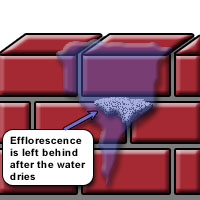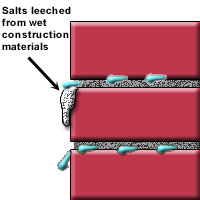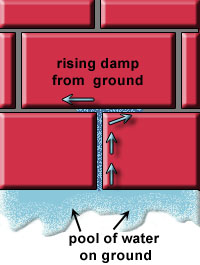Case 1
- Introduction
- Causes of Defects
- Good Practices
- Standards
- Maintenance and Diagnostics
- Remedial
- Similar Cases
- References
Cause of Defects
Efflorescence can be said to be most common and most easily noticeable defect on exposed brick walls. It has been described as usually a skin trouble and not a deep seated disease’.
Efflorescence can be summarized to be:

- The process where soluble salts in porous materials (bricks in particular) are deposited at or near the surface as a result of the evaporation of water that contains salts. Progressively, as the water evaporates, the salts crystallize out to form harmless superficial white deposits on the surface of the building.
- Efflorescence is related with water movement and dissolution of some chemical ingredients in masonry materials.
Possible sources of water:
- rain
Masonry usually absorbs all driving rain at the beginning. If the driving rain is very heavy or continues a long time, the rate of absorption can be lower than the rain load. Thus a film of water forms on the surface.
- humidity
Humidity indoors is usually higher than outdoors. When the indoor air is cooled, the relative humidty increases and condensation may occur from the inside.
- construction moisture

Large amount of water may be present after the building is completed especially with bricks and rendering .
- rising damp

Movement of water up the wall from ground by capillary action may cause dampness to the brick surface.
Consequences
- If water is allowed to migrate through the pores and cracks, and soluble salts are present for dissolution, such staining would continue.
- If problem persists, other facade defects such as poor adhesion, water seepage due to cracks and porosity and weathering of joints will follow.